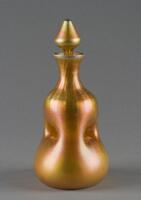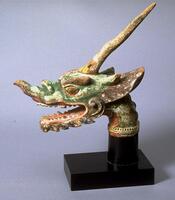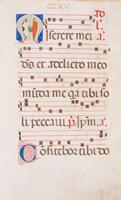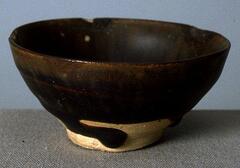27 UMMA Objects
27 UMMA Objects

Chinese (Chinese (culture or style))
Bowl
14th century
Gift of Toshiko Ogita in memory of Tomoo Ogita
1987/1.306

Louis Comfort Tiffany
Kuttrolf-like Decanter
1896 – 1900
University purchase 1930, transferred to the Museum of Art, 1972/2.221
1972/2.221

Japanese (Japanese (culture or style))
Dragon head (finial for a staff or a piece of ceremonial furniture)
1200 – 1332
Museum purchase made possible by the Margaret Watson Parker Art Collection Fund
1969/2.20
![<p>The cup has a mouth that curves slightly inwards; this is a form typical of round cups with saucers produced in large numbers in the 13th and 14th centuries. The cup is decorated only on the outer rim with a fret-patterned band. Repaired damage is visible on several parts on the mouth, as well as cracking that occurred during ring. Glaze has been applied down to the foot, and three quartzite spur marks remain on the outer base. The partially oxidized body displays darker patches on the surface, but it preserves a bright celadon color overall.<br />
[<em>Korean Collection, University of Michigan Museum of Art </em>(2014) p.120]</p>
The celadon cup has a mildly inverted rim with curved sides that are bent once, at a sharp angle, near the base. The surface is coated with a greenish blue glaze. The slightly inward-turning mouth facilitates drinking while the sides curve gently toward the base. <p>The cup has a mouth that curves slightly inwards; this is a form typical of round cups with saucers produced in large numbers in the 13th and 14th centuries. The cup is decorated only on the outer rim with a fret-patterned band. Repaired damage is visible on several parts on the mouth, as well as cracking that occurred during ring. Glaze has been applied down to the foot, and three quartzite spur marks remain on the outer base. The partially oxidized body displays darker patches on the surface, but it preserves a bright celadon color overall.<br />
[<em>Korean Collection, University of Michigan Museum of Art </em>(2014) p.120]</p>
The celadon cup has a mildly inverted rim with curved sides that are bent once, at a sharp angle, near the base. The surface is coated with a greenish blue glaze. The slightly inward-turning mouth facilitates drinking while the sides curve gently toward the base.](/media/W1siZiIsIjIwMjIvMDkvMjQvMmRjZTRvbXNlel9kZWZhdWx0LmpwZyJdLFsicCIsInRodW1iIiwiMjQweDIwMCJdXQ?sha=b6f3e998b597b135)
Korean (Korean (culture or style))
Wine cup with incised patterns
1100 – 1299
Gift of Bruce and Inta Hasenkamp and Museum purchase made possible by Elder and Mrs. Sang-Yong Nam
2004/1.225
![A yellow brownish glaze is applied and crackling covers the entire body.<br />
This bowl has straight wall. The exterior is carved with lotus petals. The below of the mouth is decorated with fret design. The foot is a little low.
<p>This is a cylindrical cup decorated with incised and raised design of lotus petals on the entire outer walls and is fretted on the outer rim. Overall, the cup is yellow-green in color and has three refractory spur marks. Many of the shards, excavated from sediment in the vicinity of Kiln no. 12 at Yucheon-ri, Buan-gun, Jeollabuk-do, are also those of cylindrical cups similar in form to this one.<br />
[<em>Korean Collection, University of Michigan Museum of Art </em>(2014) p.123]<br />
</p>
A yellow brownish glaze is applied and crackling covers the entire body.<br />
This bowl has straight wall. The exterior is carved with lotus petals. The below of the mouth is decorated with fret design. The foot is a little low.
<p>This is a cylindrical cup decorated with incised and raised design of lotus petals on the entire outer walls and is fretted on the outer rim. Overall, the cup is yellow-green in color and has three refractory spur marks. Many of the shards, excavated from sediment in the vicinity of Kiln no. 12 at Yucheon-ri, Buan-gun, Jeollabuk-do, are also those of cylindrical cups similar in form to this one.<br />
[<em>Korean Collection, University of Michigan Museum of Art </em>(2014) p.123]<br />
</p>](/media/W1siZiIsIjIwMjIvMDkvMjQvNWU0NDFuZ3Nuc19kZWZhdWx0LmpwZyJdLFsicCIsInRodW1iIiwiMjQweDIwMCJdXQ?sha=243d2e8e37f3b830)
Korean (Korean (culture or style))
Deep bowl with vertical sides and carved lotus petal design
1200 – 1399
Gift of Bruce and Inta Hasenkamp and Museum purchase made possible by Elder and Mrs. Sang-Yong Nam
2004/1.228

Tuscan;Italian
Choir Book Page
1367 – 1432
Gift of Marvin Eisenberg in memory of Evelyn Sandberg-Vavalà, beloved teacher and mentor in Florence
2006/1.97

Chinese (Chinese (culture or style))
Jian Ware "Hare's Fur" Teabowl
1100 – 1299
Gift of Mr. and Mrs. Stephen H. Spurr
2003/2.19
![<p>This octagonal dish is inlaid with a chrysanthemum design with white and black slip on each facet. Its outer base is entirely glazed and has three quartzite spur marks. The inner surface is undecorated but covered in crackles, revealing the gray body. The glaze was oxidized during ring, leaving many areas brown.<br />
[<em>Korean Collection, University of Michigan Museum of Art </em>(2014) p.117]<br />
</p>
<p>This octagonal dish is inlaid with a chrysanthemum design with white and black slip on each facet. Its outer base is entirely glazed and has three quartzite spur marks. The inner surface is undecorated but covered in crackles, revealing the gray body. The glaze was oxidized during ring, leaving many areas brown.<br />
[<em>Korean Collection, University of Michigan Museum of Art </em>(2014) p.117]<br />
</p>](/media/W1siZiIsIjIwMjIvMDkvMjQvNHVpbG92a2E1bl9kZWZhdWx0LmpwZyJdLFsicCIsInRodW1iIiwiMjQweDIwMCJdXQ?sha=811709a388c3f99f)
Korean (Korean (culture or style))
Octagonal faceted bowl with inlaid design of paired chrysanthemums on outer side
1250 – 1350
Gift of Bruce and Inta Hasenkamp and Museum purchase made possible by Elder and Mrs. Sang-Yong Nam
2004/1.234

Korean (Korean (culture or style))
Imperial Tally (Horse Medallion)
14th century
Gift of Bruce and Inta Hasenkamp and Museum purchase made possible by Elder and Mrs. Sang-Yong Nam
2004/1.257

Chinese (Chinese (culture or style))
Teabowl
13th century
The James Marshall Plumer Memorial Collection
1983/1.445
![It has a wide mouth and a shape which flared out to a generously-sized shoulder, then tapers to a slim lower body. It is a storage jar inlaid chrysanthemum, cloud and crane design.<br />
<br />
This is an ornate short-necked jar embellished with inlaid designs of clouds and cranes on its entire body. It is built by coiling due to its large size. Its shoulder and lower part of the body are inlaid with lotus petals, and the body is inlaid with cranes and chrysanthemums. Lumps of glaze are found on some parts of the body and pinpoles are found around the foot. Crazing was formed on the entire glazed surface. Shards of similar vessels had been excavated from Yucheon-ri, Buan- gun, Jeollabuk-do.<br />
[<em>Korean Collection, University of Michigan Museum of Art</em> (2014) p. 135]<br />
It has a wide mouth and a shape which flared out to a generously-sized shoulder, then tapers to a slim lower body. It is a storage jar inlaid chrysanthemum, cloud and crane design.<br />
<br />
This is an ornate short-necked jar embellished with inlaid designs of clouds and cranes on its entire body. It is built by coiling due to its large size. Its shoulder and lower part of the body are inlaid with lotus petals, and the body is inlaid with cranes and chrysanthemums. Lumps of glaze are found on some parts of the body and pinpoles are found around the foot. Crazing was formed on the entire glazed surface. Shards of similar vessels had been excavated from Yucheon-ri, Buan- gun, Jeollabuk-do.<br />
[<em>Korean Collection, University of Michigan Museum of Art</em> (2014) p. 135]<br />
](/media/W1siZiIsIjIwMjIvMDUvMjUvNHh2a2V5NzN6Nl9kZWZhdWx0LmpwZyJdLFsicCIsInRodW1iIiwiMjQweDIwMCJdXQ?sha=837137e88319b4be)
Korean (Korean (culture or style))
Storage jar with inlaid floral designs
1250 – 1350
Gift of Mrs. Henry Jewett Greene for The Mr. and Mrs. Henry Jewett Greene Memorial Collection
1972/2.33

Chinese (Chinese (culture or style))
Fragment of Jian Ware Bowl
12th century
Transfer from the School of Art and the College of Architecture and Urban Planning
1997/1.285
Loading…
